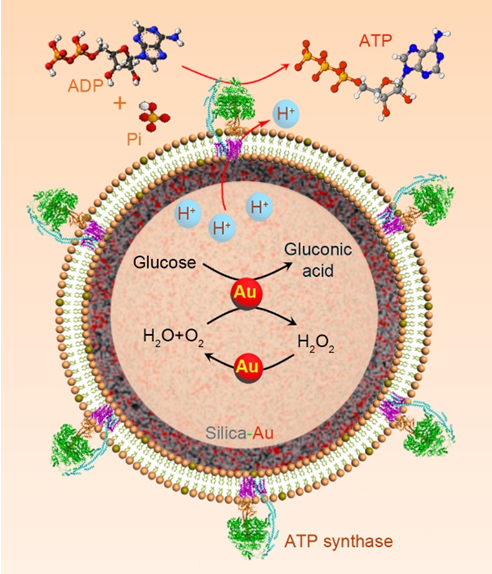Scientists Develop A New Type of ATP Synthesis Based on Nanozyme-Catalyzed Cascade Reactions
In Nature, life activities including energy conversion, information transfer and substance transportation are performed by active biomacromolecule machines. By the strategy of molecular assembly, these biomacromolecules have been utilized as building blocks to construct cell-like assemblies to mimic or modulate life activities in a controlled manner.
As an indispensable biomolecule fuel, ATP (adenosine triphosphate) is produced through oxidative phosphorylation or photophosphorylation in Nature. During the synthesis processes, natural enzymes (such as ATP synthase)-catalyzed cascade reactions are involved. At present, by mimicking natural photophosphorylation, a plethora of artificial chloroplast-like systems were prepared through integrating molecular assembly and nanobrication. Furthermore, another challenge is to design and construct mitochondrion-like systems by mimicking natural oxidative phosphorylation.
A research team led by Prof. Li Junbai from the Institute of Chemistry, Chinese Academy of Sciences developed a new type of ATP synthesis system based on nanozyme-catalyzed cascade reactions coupling with natural ATP synthase. The work was published in Angew. Chem. Int. Ed.

Mitochondria-like oxidative phosphorylation based on nanozyme-catalyzed cascade reactions to produce ATP.(Image by Prof. LI Junbai)
By using a template, through integrating sol-gel reaction, chemical modification and consequent in situ reduction, gold nanoparticles-trapped silica microspheres were fabricated. Combining synthetic gold nanoparticle-based nanozyme with natural ATP synthase, enabled the mimicked process of natural oxidative phosphorylation in the mitochondrion. The stability of the hybrid system was enhanced by using the artificial nanozyme.
Gold nanoparticles were immobilized in porous and hollow silica microspheres, which gave the solid support to spread ATP synthase-containing liposomes. In detail, glucose was oxidized by oxygen into gluconic acid by gold nanoparticles, which played a role as a glucose oxidase-like catalyst. Then a gluconic acid-generated transmembrane proton gradient was formed to drive ATP synthase to produce ATP. In addition, gold nanoparticles also possessed peroxidase-like activity to decompose H2O2 to reduce the potential damage of natural ATP synthase.
Taken together, highly efficient ATP synthesis was achieved, which was comparable to those in the natural systems. Such assembled biohybrid system shows a promising application in the field of ATP-driven bioreactions and biodevices. The work opens a new avenue to explore biological energy conversion systems.
Contact:
Prof. LI Junbai
Institute of Chemistry, Chinese Academy of Sciences
E-mail:jbli@iccas.ac.cn





